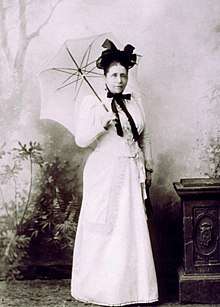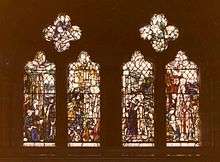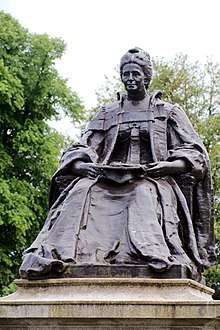Isabella Elder
Isabella Ure Elder (1828–1905) was a Scottish philanthropist who took a particular interest in education, especially of women, and in the welfare of the people of Govan, site of her husband's shipbuilding yard.
Isabella Ure Elder | |
|---|---|
 | |
| Born | 15 March 1828 Glasgow |
| Died | 18 November 1905 Glasgow |
| Occupation | Philanthropist |
Early life, marriage and widowhood
Isabella Ure was born to Mary Ure (née Ross) on 15 March 1828 in Glasgow's Gorbals district. Her father, Alexander Ure (1788–1830), was a solicitor. She was the only surviving daughter of the family, however, she had one older brother, John Francis (1820–1883). Her education is unknown.[1]
In 1857 Isabella married John Elder (1824–1869), a partner in marine engineers Randolph, Elder & Co. In 1860 the thriving business acquired a shipyard at Govan, and in 1868 became known as John Elder & Co. By the time John Elder died in 1869 it was regarded as one of the world's leading shipbuilders.[2]
Following her husband's death, Elder became the sole owner of the business and ran it successfully for nine months until it was transferred to a partnership led by her brother.[1][2] As a wealthy widow with no children, she toured the Continent for extended periods and also became a major philanthropist in Glasgow.[3][4]
Philanthropy
During her widowhood, Elder lived at 6 Claremont Terrace, next to Kelvingrove Park and close to the University of Glasgow in which she took a keen interest.[5] Her donations to the university included £5000 to support the Chair of Civil Engineering, in 1873, and £12500 to fund the endowment of the John Elder Chair of Naval Architecture, in 1883.[6]
The Glasgow and West of Scotland Technical College, now University of Strathclyde, received a £5000 endowment in her will to fund a series of "Lectures of Descriptive Astronomy", named the David Elder lectures in honour of her father-in-law.[7]
In 1883, Elder purchased North Park House in Glasgow's West End. She provided the property, rent free, to house Queen Margaret College had been founded as the first college in Scotland to offer higher education to women. She also provided the financial support needed for the Collage to offer courses in medicine to women, starting in 1890.[2] The courses were taught by staff from University of Glasgow, however, it was initially not possible for women to qualify for a degree. The Collage became a part of University of Glasgow in 1892 after the announcement by the University Commissioners (Scotland) that women would be accepted into universities, with the first graduations in medicine in 1894 and in arts in 1895. Elder was concerned that women would receive sub-standard teaching if taught separately, and she only agreed to hand over North Park House to the University on condition that the teaching provided to women was equal to that of men. She was disappointed in the standard of lecturing, however, and in 1899 refused to give the Principal more money unless the original agreement was kept.[1]
Many of Elder's philanthropic projects were sited in Govan. In 1883 she purchased 37 acres near Elder's Fairfield Shipyard and created Elder Park, named in honour of her husband and her father-in-law, David. It opened on 27th June 1885 and for many years she paid for an annual display of fireworks there. Also in 1885, she set up a School for Domestic Economy where young women learned how to cook and perform other household tasks on a limited budget.[2] In 1901, she funded the building and stocking of Elder Free Library, which is sited in one corner of Elder Park and remains open to the community, and also provided a villa for the Cottage Nurses Training Home. In 1903 she provided the funds to build the Elder Cottage Hospital, and she continued to fund this enterprise until her death.[1][5]
Death
Isabella died at her home in Glasgow on 18 November 1905 of heart failure, gout and bronchitis. Her death certificate was signed by Dr Marion Gilchrist, the first woman to graduate in medicine in Glasgow, and on 22 November she was buried in the family tomb in Glasgow Necropolis. Her will left more than £125000 for charitable purposes including the Ure Elder Fund for Indigent Widows of Govan and Glasgow.[1]
Tributes

The University of Glasgow awarded Elder an honorary degree (LLD) in 1901. Its publication, The Baillie, described her as "a true woman, a wise benefactress of the public and of learning." In December 2015, the University named a building after her.[8] She is also commemorated on the University's Memorial Quincentennial Gates and in a memorial window in Bute Hall, titled The Pursuit of Ideal Education, where she is pictured alongside Janet Anne Galloway and Jessie Campbell.[2]

In 1906 a bronze statue of Elder on a granite base and surrounded by a memorial garden, was unveiled in Elder Park by the Provost of Govan, Sir John Anthony. Elder is shown seated, wearing her academic gown with her mortar board in her lap. The sculptor was Glasgow graduate Archibald Macfarlane Shannan (1850–1915) and the £2000 cost was raised by public subscription, much of it from the ordinary people of Govan who held her in high regard.[9][10] It was the first statue of a woman (other than Queen Victoria in George Square) in Glasgow, and remains one of only four statues commemorating specific named women, rather than allegorical figures. (The third is La Pasionaria on the Clyde Walkway and the fourth, erected in Govan in March 2018, is of Mary Barbour.) The statue is Category A Listed and the monument and memorial gardens were restored in 2010.[11][12]
Another Elder Park exists in Adelaide, Australia, however, this is named for a different Elder family. At one time, both parks had a similar bandstand, however the Govan one has since been lost.[13]
The life and work of Isabella Elder was examined as part of the Govan’s Hidden Histories project, and she also has her own Facebook Page. Her biography was written by Joan McAlpine in 1997.[14]
References
- McAlpine, C. Joan. "Isabella Elder". Oxford DNB. Oxford UP. Retrieved 16 November 2013.
- "University of Glasgow :: Story :: Biography of Isabella Elder". www.universitystory.gla.ac.uk. Retrieved 16 March 2017.
- "Isabella Elder". Undiscovered Scotland. Undiscovered Scotland. Retrieved 16 November 2013.
- Fraser, W. Hamish. "Isabella Elder". The Glasgow Story. Glasgow Story. Retrieved 16 November 2013.
- "Mrs Elder – pioneer". The Friends of Glasgow Necropolis. Friends of Glasgow Necropolis. Retrieved 16 November 2013.
- "University of Glasgow :: Story :: Professorships: Naval Architecture and Ocean Engineering (John Elder Chair)". universitystory.gla.ac.uk. Retrieved 24 June 2020.
- "David Elder Lectures | University of Strathclyde". www.strath.ac.uk. Retrieved 24 June 2020.
- "University of Glasgow - MyGlasgow - Campus e-News - Archives - 2015 - December - Isabella Elder Building". www.gla.ac.uk. Retrieved 15 March 2017.
- "Elder Park". Clyde Waterfront Heritage. Clyde Waterfront. Archived from the original on 4 November 2013. Retrieved 16 November 2013.
- "Isabella Elder Statue". Sunny Govan. Sunny Govan. Retrieved 16 November 2013.
- Glasgow City Council. "Monuments to John and Mrs Elder in Elder Park". Glasgow City Council. Retrieved 16 November 2013.
- Glasgow City Council. "Statue salutes Glasgow's first female councillor". Glasgow City Council. Retrieved 16 November 2013.
- "Elder Park". SA History Hub. Retrieved 26 February 2018.
- McAlpine, C Joan (1997). The lady of Claremont House : Isabella Elder : pioneer and philanthropist. Glendaruel: Argyll Publishing. ISBN 1874640971.